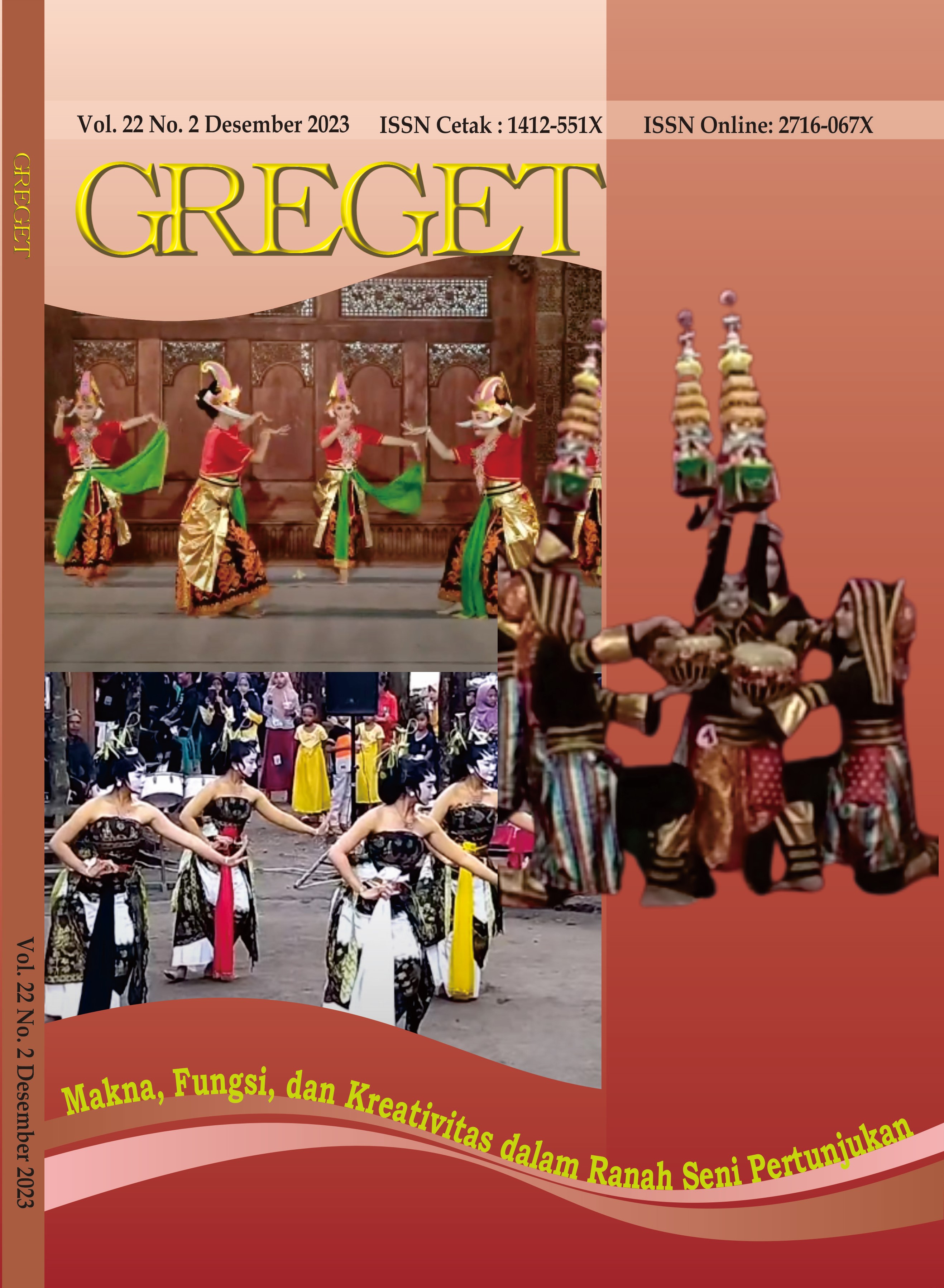KOREOGRAFI PELUK JIWA KARYA JONET SRI KUNCORO DAN MT. WASI BANTOLO BERSAMA ANAK DISABILITAS TUNA RUNGU
Main Article Content
Abstract
This study describes the process of creation and form of Peluk Jiwa dance. The problems in this study include process of creating Peluk Jiwa dance choreography and form of Peluk Jiwa dance. The choreography of Peluk Jiwa is based on the traditional Surakarta style dance movements that are balanced and adapted to the abilities of the dancers who are deaf children, non-disabled children and physically disabled singers. The dance work Peluk Jiwa tells about social equality between normal people and people with physical disabilities. This study uses a qualitative method that is descriptive analysis. The theory used to solve the problem of the choreography creation process uses a theory with seven stages, namely elements of dance moves, theme selection, technique, exploration, organization, unity, presentation while to dissect the form of the work of Peluk Jiwa Dance using nine main elements including (1) dance title, (2) dance themes, (3) types of dance, (4) dance room, (5) dance moves, (6) dance music, (7) presentation methods, (8) dancers, (9) makeup and clothing. The results of this study indicate that Peluk Jiwa Dance is the work of Jonet Sri Kuncoro and Wasi Bantolo with children hearing impairments who were created through a seven-stage creative process and also added that the form of Peluk Jiwa is a drama dance involving dancers for children with hearing impairments. This work contains a message of social equality between children with hearing impairments and normal children.
Downloads
Article Details

This work is licensed under a Creative Commons Attribution-ShareAlike 4.0 International License.
Copyright
Authors who publish with GREGET agrees to the following terms:
- Authors retain copyright and grant the journal right of first publication with the work simultaneously licensed under a Creative Commons Attribution-ShareAlike 4.0 (CC BY-SA 4.0) that allows others to share the work with an acknowledgment of the work's authorship and initial publication in this journal.
- Authors are able to enter into separate, additional contractual arrangements for the non-exclusive distribution of the journal's published version of the work (e.g., post it to an institutional repository or publish it in a book), with an acknowledgment of its initial publication in this journal.
- Authors are permitted and encouraged to post their work online (e.g., in institutional repositories or on their website) prior to and during the submission process, as it can lead to productive exchanges, as well as earlier and greater citation of published work.
References
Agustiningrum, B. (2014). Penanaman
Proses Pendisplinan Diri Anak Berkebutuhan Khusus (Tuna Rungu Wicara) Dalam Pembelajaran Tari Tradisional
Ahmad, A. (2019). Breathe. Skripsi S1 Jurusan Tari Institut Seni Indonesia Yogyakarta.
Amelia, R. (2016). Koreografi Aku Bisa Karya Jonet Sri Kuncoro dalam Ketubuhan Kaum Difabel Tunarungu di SLB N dan SDLB dan SMPLB Bina Karya Insani Cangakan Karanganyar. Skripsi S1 Jurusan Tari Institut Seni Indonesia Surakarta.
Andari, R. Y. (2019). Pengaruh Permainan Dhakon Terhadap Kemampuan Berhitung Penjumlahan Anak Tuna Grahita Kelas II C SLB N Surakarta Tahun Pelajaran 2018/2019. Skripsi S1 Jurusan Pendidikan Luar Biasa, Fakultas Keguruan dan Ilmu Pendidikan Universitas Sebelas Maret Surakarta.
Armstrong, T. (2002). Setiap anak cerdas. PT Gramedia Pustaka Utama.
Effendi, M. (2006). Pengantar psikopedagogik anak berkelainan. Bumi Aksara.
Hadi, Y. S. (2003). Aspek-aspek Dasar Koreografi Kelompok. Elkaphi.
Jazuli, M. (2014). Sosiologi Seni: Pengantar dan Model Studi Seni. Edisi 2. Graha Ilmu.
Maulana, M. M., & Mahmudah, A. S. R. (2021). Resensi Buku Memahami Anak Berkebutuhan Khusus. Center for Open Science.
Nida, F. L. K. (2018). Membangun Konsep Diri Bagi Anak Berkebutuhan Khusus. ThufuLA: Jurnal Inovasi Pendidikan Guru Raudhatul Athfal
Tobroni, M. I. (2013). Menggali Kreativitas Seni pada Anak Berkebutuhan Khusus. Humaniora, 4(1).
Wahyudi, D. B. (2011). Tari Gaya Surakarta II. Bahan Ajar Jurusan Tari, Fakultas Seni Pertunjukan, Institut Seni Indonesia Surakarta.
Widyastutieningrum, S. R., & Wahyudiarto, D. (2014). Pengantar Koreografi. ISI Press.
Diskografi
“Tari Peluk Jiwa.” Koleksi Wasi Bantolo yang dipresentasikan dalam Festival Tari Disabilitas oleh NAFA (Nanyang Academy of Fine Art) tanggal Minggu, 4 April 2021 di Teater Besar Institut Seni Indonesia Surakarta.
